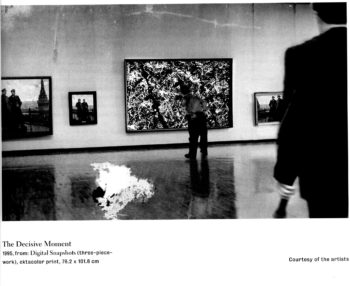DIGITAL SNAPSHOTS.
1. Photography & Truth. Photographs are commonly perceived as the Truth. A photographic image acts as a witness testifying to a unique event that took place in a distinct moment of time.
This condition is reversed in the case of a digital photograph which, according to its interpreters, is destined to lie. Indeed, the mass media has repeatedly reported on the techniques of digital manipulation which allow for the alteration of photographs in ways which are virtually undetectable and the creation of fake photographs of events which never occurred. The digital photographs which accompany these reports follow a predictable pattern: they represent the extraordinary. First they often show impossible events. Second, they utilize famous historical figures/media personalities and/or well-known photographs. Consider these typical fakes: Marilyn Monroe embraces Abraham Lincoln; George Bush and Margaret Thatcher are moved closer together to suggest an intimate conversation they never had.
2. The Snapshot. Susan Sontag has argued that snapshots give people an imaginary possession of their past. Historical memory is therefore constructed from photographs of events deemed worthy of recording. But what about memories from a culture that did not have the tradition of the snapshot? How would these memories be visualized?
3. Missing Snapshots. One day Natalie Bookchin, an American artist, asked Lev Manovich, an artist born in Moscow, to show her snapshots of his life in the Soviet Union. He had no snapshots to show. In contrast to America where practically everybody owns a camera, and where personal histories run parallel to the history and evolution of Kodak, the U.S.S.R. did not have a popular photographic culture. One had to befriend an amateur photo enthusiast or to go to a professional studio to get their picture taken. The culture of the snapshot — the imperfect, hurried capturing of a moment in one’s history — did not exist.
4. The Digital Snapshot. So far, the digital manipulation of photographs has been associated with lying and with the extra-ordinary.
-We will use digital photography not to lie but to tell the truth.
-We use digital photography to simulate not the extraordinary but the ordinary.
In our project we fabricate missing snapshots. Rather than beginning with memories based on photographs (which is how popular memory functions, according to Sontag) we will construct images based on memory and imagination. These images combine real memories of Lev’s life in Moscow with American fantasies of what it must have been like – the fantasies of the “Evil Empire.” The images also bring together the codes of Western snapshot tradition (the blur, the awkward crop, the impact of the flash) and the peculiar aesthetics of Soviet visual culture, in which photographs often looked like paintings and paintings often looked like photographs. And, of course, just as real snapshots are never a result of an innocent eye but are conditioned by the codes and styles of the visual culture of the time, our snapshots point to classic photographic practices — pictorialism, soft pornography, constructivism, the decisive moment. Furthermore, stamped on the surface of the images – like tattoos – are marks, scratches and textures from famous historical photographs. These elements come together to construct a photographic aesthetic which never existed — the aesthetics of Soviet snapshot photography.
Text by Natalie Bookchin and Lev Manovich 1994
